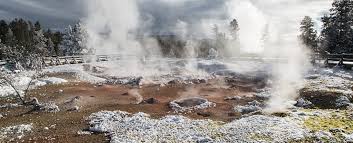Two newly discovered super-eruptions have been found hidden in the geological history of Yellowstone National Park – including one that ranks in the fifth biggest volcanic eruption of all time.
Source: Science Alert
The good news is that these additions suggest activity at the magma-fuelled hotspot is actually on the wane, according to a new study.
That’s despite the recent eruption clusters detected around the Yellowstone Caldera volcanic hollow.
The two new-found events have been named the McMullen Creek eruption (occurring about 8.99 million years ago) and the Grey’s Landing eruption (occurring about 8.72 million years ago), and they significantly adjust Yellowstone’s long-term volcanic timeline – and appear to show that huge eruptions are now occurring way less frequently than they once did.
Scientists were able to use a combination of chemical, magnetic, and radio-isotopic analysis to link volcanic deposits across tens of thousands of square kilometres (or several thousand square miles), joining together geological records that were previously treated as separate.
In other words, what had been seen as many smaller eruptions were in fact two giant ones.
“We discovered that deposits previously believed to belong to multiple, smaller eruptions were in fact colossal sheets of volcanic material from two previously unknown super-eruptions at about 9.0 and 8.7 million years ago,” says volcanologist Thomas Knott, from the University of Leicester in the UK.
“The younger of the two, the Grey’s Landing super-eruption, is now the largest recorded event of the entire Snake-River–Yellowstone volcanic province. It is one of the top five eruptions of all time.”
According to the study data and estimates, Grey’s Landing would have covered an area the size of New Jersey in ultra-hot volcanic glass – somewhere in the region of 23,000 square kilometres (or 8,880 square miles). It would have vapourised anything in its path, and spewed out a cloud of fine ash across the globe.
With both newly identified events occurring during the Miocene period (23–5.3 million years ago), it raises the number of Yellowstone super-eruptions during that time to six – or one every 500,000 years, on average.
Compare that to the two super-eruptions that are thought to have happened across the same region during the last three million years, an average of one every 1.5 million years or so, and it seems as though the activity is getting more sporadic.
“It therefore seems that the Yellowstone hotspot has experienced a three-fold decrease in its capacity to produce super-eruption events,” says Knott. “This is a very significant decline.”
Super-eruptions, which are described as “landscape-changing extreme events that perturb global climate and devastate environments” in the published paper, need to register a magnitude 8 on the official Volcanic Explosivity Index (VEI).
But just because they appear to be getting less common doesn’t necessarily mean we can lower our guard when it comes to anticipating the next cataclysmic event – even if it might not happen for hundreds of thousand years.
Keeping the Yellowstone geysers, mudpots, and fumaroles under close observation remains a “must” according to the scientists. Even if activity in the Yellowstone region is on the wane, that doesn’t mean that it’s dormant yet. Meanwhile, the same techniques used here could be applied elsewhere in the future.
“We hope the methods and findings we present in our paper will enable the discovery of more new super-eruption records around the globe,” says Knott.
The research has been published in Geology.
Source: Science Alert

































Leave a Comment
You must be logged in to post a comment.